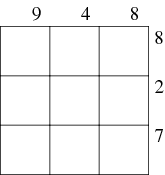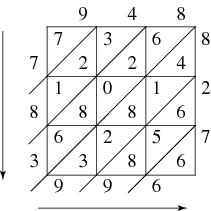

تاريخ الرياضيات

الاعداد و نظريتها

تاريخ التحليل

تار يخ الجبر

الهندسة و التبلوجي


الرياضيات في الحضارات المختلفة

العربية

اليونانية

البابلية

الصينية

المايا

المصرية

الهندية


الرياضيات المتقطعة

المنطق

اسس الرياضيات

فلسفة الرياضيات

مواضيع عامة في المنطق


الجبر

الجبر الخطي

الجبر المجرد

الجبر البولياني

مواضيع عامة في الجبر

الضبابية

نظرية المجموعات

نظرية الزمر

نظرية الحلقات والحقول

نظرية الاعداد

نظرية الفئات

حساب المتجهات

المتتاليات-المتسلسلات

المصفوفات و نظريتها

المثلثات


الهندسة

الهندسة المستوية

الهندسة غير المستوية

مواضيع عامة في الهندسة

التفاضل و التكامل


المعادلات التفاضلية و التكاملية

معادلات تفاضلية

معادلات تكاملية

مواضيع عامة في المعادلات


التحليل

التحليل العددي

التحليل العقدي

التحليل الدالي

مواضيع عامة في التحليل

التحليل الحقيقي

التبلوجيا

نظرية الالعاب

الاحتمالات و الاحصاء

نظرية التحكم

بحوث العمليات

نظرية الكم

الشفرات

الرياضيات التطبيقية

نظريات ومبرهنات


علماء الرياضيات

500AD

500-1499

1000to1499

1500to1599

1600to1649

1650to1699

1700to1749

1750to1779

1780to1799

1800to1819

1820to1829

1830to1839

1840to1849

1850to1859

1860to1864

1865to1869

1870to1874

1875to1879

1880to1884

1885to1889

1890to1894

1895to1899

1900to1904

1905to1909

1910to1914

1915to1919

1920to1924

1925to1929

1930to1939

1940to the present

علماء الرياضيات

الرياضيات في العلوم الاخرى

بحوث و اطاريح جامعية

هل تعلم

طرائق التدريس

الرياضيات العامة

نظرية البيان
Lattice Method
المؤلف:
المرجع الالكتروني للمعلوماتيه
المصدر:
المرجع الالكتروني للمعلوماتيه
الجزء والصفحة:
...
2-11-2019
1589
Lattice Method

The lattice method is an alternative to long multiplication for numbers. In this approach, a lattice is first constructed, sized to fit the numbers being multiplied. If we are multiplying an  -digit number by an
-digit number by an  -digit number, the size of the lattice is
-digit number, the size of the lattice is  . The multiplicand is placed along the top of the lattice so that each digit is the header for one column of cells (the most significant digit is put at the left). The multiplier is placed along the right side of the lattice so that each digit is a (trailing) header for one row of cells (the most significant digit is put at the top). Illustrated above is the lattice configuration for computing
. The multiplicand is placed along the top of the lattice so that each digit is the header for one column of cells (the most significant digit is put at the left). The multiplier is placed along the right side of the lattice so that each digit is a (trailing) header for one row of cells (the most significant digit is put at the top). Illustrated above is the lattice configuration for computing  .
.

Before the actual multiplication can begin, lines must be drawn for every diagonal path in the lattice from upper right to lower left to bisect each cell. There will be 5 diagonals for our  lattice array.
lattice array.

Now we calculate a product for each cell by multiplying the digit at the top of the column and the digit at the right of the row. The tens digit of the product is placed above the diagonal that passes through the cell, and the units digit is put below that diagonal. If the product is less than 10, we enter a zero above the diagonal.
Now we are ready to calculate the digits of the product. We sum the numbers between every pair of diagonals and also between the first (and last) diagonal and the corresponding corner of the lattice. We start at the bottom half of the lower right corner cell (6). This number is bounded by the corner of the lattice and the first diagonal. Since this is the only number below this diagonal, the first sum is 6. We place the sum along the bottom of the lattice below the rightmost column.

Next we sum the numbers between the previous diagonal and the next higher diagonal:  . We place the 9 just below the bottom of the lattice and carry the 1 into the sum for the next diagonal group. (The diagonals are extended for clarity.)
. We place the 9 just below the bottom of the lattice and carry the 1 into the sum for the next diagonal group. (The diagonals are extended for clarity.)
We continue summing the groups of numbers between adjacent diagonals, and also between the top diagonal and the upper left corner. The final product is composed of the digits outside the lattice which were just calculated. We read the digits down the left side and then towards the right on the bottom to generate the final answer: 783996.
Although the process at first glance appears quite different from long multiplication, the lattice method is actually algorithmically equivalent.
 الاكثر قراءة في نظرية الاعداد
الاكثر قراءة في نظرية الاعداد
 اخر الاخبار
اخر الاخبار
اخبار العتبة العباسية المقدسة

الآخبار الصحية















 "المهمة".. إصدار قصصي يوثّق القصص الفائزة في مسابقة فتوى الدفاع المقدسة للقصة القصيرة
"المهمة".. إصدار قصصي يوثّق القصص الفائزة في مسابقة فتوى الدفاع المقدسة للقصة القصيرة (نوافذ).. إصدار أدبي يوثق القصص الفائزة في مسابقة الإمام العسكري (عليه السلام)
(نوافذ).. إصدار أدبي يوثق القصص الفائزة في مسابقة الإمام العسكري (عليه السلام) قسم الشؤون الفكرية يصدر مجموعة قصصية بعنوان (قلوب بلا مأوى)
قسم الشؤون الفكرية يصدر مجموعة قصصية بعنوان (قلوب بلا مأوى)


















